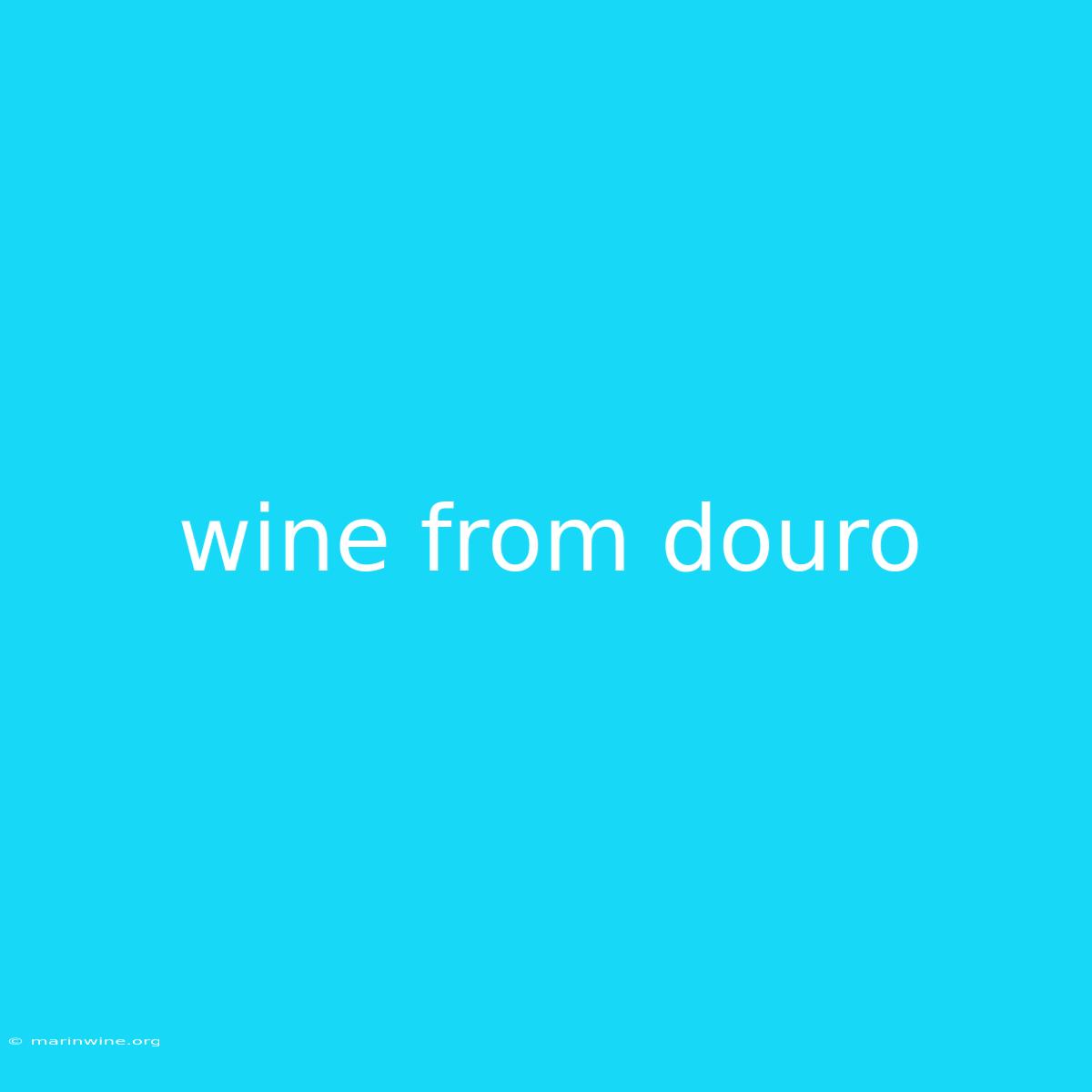Uncorking the Treasures of the Douro: A Journey into Portuguese Winemaking
Have you ever wondered what makes Douro wines so unique? It's more than just the stunning landscapes and centuries-old vineyards. The Douro Valley, nestled in northern Portugal, boasts a rich history of winemaking that has produced some of the world's most prized and complex wines.
Why It Matters: This article delves into the world of Douro wines, exploring the region's unique terroir, grape varieties, and winemaking techniques. We'll uncover the secrets behind the distinctive flavors and styles that make Douro wines stand out.
Key Takeaways of Douro Wine:
| Feature | Details |
|---|---|
| Region | Douro Valley, Portugal |
| Climate | Mediterranean with hot summers and mild winters |
| Soil | Schist, granite, and sandy soils |
| Grape Varieties | Touriga Nacional, Touriga Franca, Tinta Roriz, and many more |
| Wine Styles | Red, White, Port, and Sparkling |
| Characteristics | Full-bodied, complex, earthy, spicy, and fruit-forward |
The Douro Valley: Where Tradition Meets Innovation
The Douro Valley, a UNESCO World Heritage Site, is a landscape sculpted by centuries of viticulture. Steep slopes, terraces carved into the hillsides, and ancient vineyards paint a picture of dedication and resilience.
Key Aspects:
- Terroir: The unique combination of climate, soil, and geography in the Douro Valley creates a distinctive terroir that influences the flavor profile of the wines. The schist soils, in particular, contribute to the mineral and earthy notes found in many Douro wines.
- Grape Varieties: The Douro boasts a diverse range of grape varieties, including the dominant Touriga Nacional, Touriga Franca, and Tinta Roriz. These grapes, alongside many others, contribute to the complexity and depth of flavor that Douro wines are known for.
- Winemaking Techniques: Winemakers in the Douro employ traditional methods, often using foot-treading and open-top fermentation, alongside modern techniques to produce a wide range of styles.
The Influence of Port Wine on Douro's Identity
Port, a fortified wine with a long history in the Douro, has profoundly impacted the region's winemaking traditions.
Key Aspects:
- Fortification: The addition of brandy during fermentation, a key characteristic of Port, raises the alcohol content and contributes to the wine's unique aging potential.
- Aging: Port wines are aged in oak barrels, developing complex aromas and flavors over time. This aging process, a crucial part of Port production, also influences the style of red Douro wines.
- Legacy: The legacy of Port has shaped the Douro's winemaking landscape, influencing the grape varieties, viticultural practices, and winemaking techniques employed in the region.
Exploring Beyond Port: The Rise of Still Douro Wines
In recent years, still Douro wines have experienced a surge in popularity, gaining recognition for their quality and character.
Key Aspects:
- Versatility: Douro wines offer a range of styles, from full-bodied and complex reds to vibrant and aromatic whites. This versatility makes them a perfect match for diverse cuisines and preferences.
- Quality: The high quality of Douro wines is evident in their intricate aromas, intense flavors, and impressive aging potential.
- Emerging Trends: Winemakers in the Douro are embracing new techniques, experimenting with different grape varieties, and producing innovative wines that push the boundaries of traditional styles.
Douro Wine: A Table of Key Insights:
| Aspect | Description |
|---|---|
| Grape Varieties | Over 100 indigenous and international grape varieties |
| Wine Styles | Reds, Whites, Ports, Sparkling, and even Rosé |
| Flavor Profile | Intense fruit, spicy notes, earthy undertones, mineral complexity |
| Aging Potential | Many Douro wines are designed for long aging, developing complex aromas and flavors over time |
| Food Pairings | Reds pair well with hearty meat dishes, game, cheeses, and chocolate. Whites complement seafood, poultry, and salads. |
FAQ: Douro Wine
Q: What is the difference between a Douro Red and a Port Wine? A: Douro Red is a still wine, while Port is fortified with brandy during fermentation, resulting in a higher alcohol content and a unique aging potential.
Q: Why is Douro wine so expensive? A: The steep terrain, traditional winemaking methods, and limited production contribute to the higher cost of Douro wines.
Q: What are the best Douro wines to try? A: There are numerous acclaimed producers in the Douro, each with its own unique style. Research and discover the wines that best suit your taste.
Q: What is the best way to serve Douro wine? A: Reds are best served at room temperature, while whites are best enjoyed chilled.
Tips for Enjoying Douro Wine:
- Start with a Classic: Explore the traditional styles of Douro wines, including the full-bodied reds and the complex Ports.
- Explore the Diverse Styles: Discover the breadth of Douro wines, ranging from elegant whites to innovative blends.
- Pair with Food: Pair Douro wines with dishes that complement their flavor profiles.
- Visit the Douro: Immerse yourself in the Douro Valley's stunning landscape and learn about the region's winemaking traditions firsthand.
Summary of Douro Wine:
The Douro Valley, a region steeped in history and tradition, produces wines that are renowned for their complexity, character, and aging potential. From the iconic Port wines to the rising popularity of still Douro wines, this region continues to fascinate and delight wine lovers around the world.
Closing Message: As you embark on your journey into the world of Douro wines, embrace the adventure of discovery. Explore the diverse styles, appreciate the rich history, and savor the unique flavors that make these wines truly exceptional.

